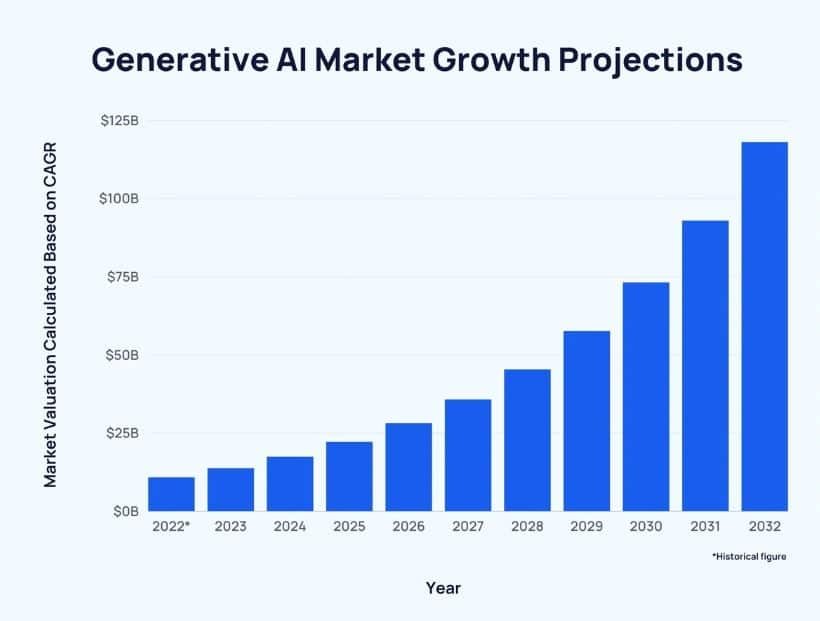Tech
XR Meets Generative AI: What’s Next For Smart Immersivity?

As the demands for immersive XR experiences grow, could AI be the game-changer developers have been looking for?
For a number of innovators across the technology landscape, AI and XR could be considered a match made in heaven. Combining machine learning with virtual experience design could result in a future of automated virtual experiences, live content generation and accurate haptic feedback powered by supercomputing.
“AR and VR technologies are like two sides of a coin. AR overlays digital information onto our physical world, while VR creates fully immersive digital environments,” says Chelsea Donovan, senior manager of corporate digital experience at Genentech.
“It’s safe to say that the fusion of generative AI with AR and VR is no longer just the stuff of sci-fi. It’s here and revolutionising how we work, play and interact with the world around us,” she claims.
As XR companies accelerate, AI is set to play a crucial role in making digital environments more powerful. With that in mind, let’s have a closer look at how generative AI could drive a future of smart immersivity.
Is Generative AI On The Rise?
It’s no secret that generative AI is on the rise. According to Exploding Topics, by 2025 alone, the generative AI market will be worth more than $22 billion.
On the back of the release of intuitive chatbots such as ChatGPT, digital natives across the world are spending more time than ever connecting with AI and using machine learning to enhance daily tasks and practices.

(Image Source: Exploding Topics)
“The latest generative AI applications can perform a range of routine tasks, such as the reorganization and classification of data. But it is their ability to write text, compose music, and create digital art that has garnered headlines and persuaded consumers and households to experiment on their own,” states Michael Chui, McKinsey Global Institute Partner.
“As a result, a broader set of stakeholders are grappling with generative AI’s impact on business and society but without much context to help them make sense of it,” he says.
The question is, could the XR industry speed up the adoption of generative AI? Let’s find out.
XR Meets Generative AI: A Match Made In Heaven?
Experts are calling it a match made in heaven, and developers are welcoming an automated tomorrow, but what does the partnership between AI and XR mean for us?
Smart immersion. As we combine AI-powered automation and multi-language processors with VR design, we get a more powerful immersive experience. AI-driven XR means that virtual reality can be personalised to the user and could become limitless in terms of content. Generating virtual reality experiences in a live space takes pressure away from development and allows VR/AR consumers to navigate their own journeys.
Here are some of the areas AR could transform in the XR world:
AI-Powered Automation
Generative AI tools such as chatGPT offer XR developers to create larger reels of content much more efficiently. With the ability to read and act on data in real time, AI content bots can keep generating new virtual content while the user is still hooked up to the headset.
Take the VR company Moth+Flame for example. As experts in creating VR-powered training programmes, M+F have recently launched an AI-powered learning experience for companies interested in creating on-demand immersive learning.
“The biggest challenge for all education is the scale of content creation. So much enterprise training is limited to low-scoring e-learning products because of scale limitations,” said Kevin Cornish, CEO of Moth+Flame. “So much enterprise training is limited to low-scoring e-learning products because of scale limitations. With this tool, enterprises will be able to scale their content creation across all use cases in virtual reality, the most effective training modality available.”
Generative AI not only aids M+F to create content at speed, but each user can enjoy a personalised experience based on the feedback they provide. With each movement and action, the AI-powered XR experience adapts in real-time to mimic the domino effects of the physical world.
Personalising Platform Experiences
Another tech giant enjoying the benefits of generative AI and XR development is Microsoft. As one of the market leaders in both landscapes, it aims to deliver impressive immersive experiences to its consumers using high-speed simulation and platform personalisation.
Partnering with computing pioneer NVIDIA, Microsoft aims to help users unlock new opportunities to be productive in an XR environment. Installing self-learning algorithms to their popular VR platforms, users will be able to rapidly create text, video and images in seconds, aiding collaboration and training in a corporate environment.
“Microsoft Azure Machine Learning users come to the platform expecting the highest performing, most secure development platform available,” says John Montgomery, corporate vice president of AI platform at Microsoft. “Our integration with NVIDIA AI Enterprise software allows us to meet that expectation, enabling enterprises and developers to easily access everything they need to train and deploy custom, secure large language models.”
Improving both flexibility and efficiency, each user of the Microsoft Azure platform can enjoy personalisation and generate smart immersivity in real-time.
Humanising Communication In XR
AI also has the power to humanise aspects of XR. Generative AI aids natural language processing. If you’ve used ChatGPT, you’ll know that AI can certainly mimic traditional conversation structures and reply back as if you were talking to another human.
“Generative AI, specifically large language models (LLMs), unlocks a wealth of opportunities for organizations to transition from developers leading the timing cycles to launch a solution to non-technical users leading the charge,” say experts at Petrosino. “LLMs allow non-technical users to communicate an idea in plain text to build an augmented or virtual reality experience.”
Communication within an XR-generated environment is vital. As the metaverse expands and we live more of our lives in an online world, the ability to mimic real-life conversation is crucial.
What’s Next For AI and XR?
We’ve only seen the beginning of what AI can do for the XR world. From automating content generation to personalising platform experiences, we’re quickly entering a new era of smart immersivity.
The question is, where could this match made in heaven go next? As generative AI becomes more prevalent within the online world, could it replace the role of XR developers altogether? If users can generate VR experiences in real-time with the help of machine learning, could we see a future of self-led games, learning and entertainment? Only time will tell.
-

 Celebrity4 weeks ago
Celebrity4 weeks agoIs YNW Melly Out Of Jail? What Is The YNW Melly Release Date, Career, Early Life, And More
-

 Sports4 weeks ago
Sports4 weeks agoMore Than Just a Game: How College Sports Can Shape Your Future
-

 Tech3 weeks ago
Tech3 weeks agoAI Software: Transforming the Future of Technology
-

 Tech3 weeks ago
Tech3 weeks agoAll About Com. Dti. Folder Launcher: Features, Benefits, Tips, And More













